Level 1, 75 Talavera Road
Macquarie University
A decade of impactful research
The focus of our research effort is to change the survival and quality of life of people with MND.
The Centre works closely with the multidisciplinary MND service and clinic as well as our Neurodegenerative Disease Biobank. By working in collaboration, our research is used to develop new ways to diagnose and treat MND.
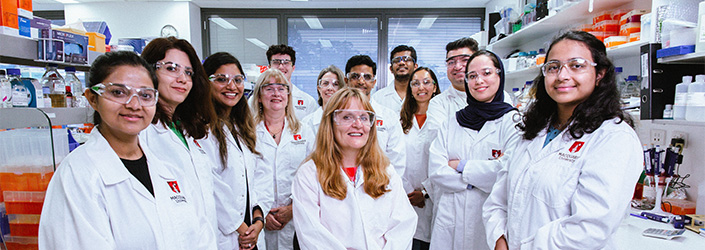
Cellular biology and therapeutics
By discovering processes in cells that cause MND, researchers can identify new drugs to slow or stop this degeneration.
Led by Professor Julie Atkin, the cellular biology and therapeutics team has spent the last decade researching the cellular details of MND. During this time, we have advanced from discovering cellular processes related to MND to actively testing new drugs.
Atkin’s team has made large strides in cellular research, with significant discoveries including:
- TDP-43 protein: Demonstrated that the most important protein linked to MND, TDP-43, normally repairs DNA.
- C9orf72: For C9orf72, which causes familial MND when mutated, their studies showed that this protein is normally required for cellular transport and in processes that cells use to get rid of damaged proteins.
- FUS protein: Identified a form of the FUS protein that aggregates outside cells, unlike typical MND-related proteins. The team received a National Health and Medical Research Council grant to further investigate this protein.
The breakthroughs in understanding cellular mechanisms for MND hold the promise of new treatments. Our research has progressed from cell-level discoveries to practical drug development:
- Drug testing: Over the past decade, we have tested three new drugs on cells, zebrafish and mice. The drugs have been shown to protect motor neurons and improve motor performance in these animals.
- Patents: Patents for these therapies are currently awaiting approval, marking a significant step towards clinical applications.
- Human trials: Collaborating with chemists at La Trobe University in Melbourne, we are working to ensure these drugs are suitable for human use. If successful, these drugs may eventually advance to human clinical trials.
The journey from cellular discoveries to effective treatments is a long and challenging one, but the team’s dedication and innovative research methods hold the potential to make a difference in the lives of MND patients and their families.
Group leader: Professor Julie Atkin
Team leader:
Group members:
- Zeinab Takallo Bighash
- Fabiha Farzana
- Emmaline Frogley
- Shashi Gautam
- Julie Hunter
- Dr Cyril Jones-Jagaraj
- Sara Assar Kashani
- Dr Prachi Mehta
- Dr Sayan Saravanabavan
- Dr Sina Shadfar
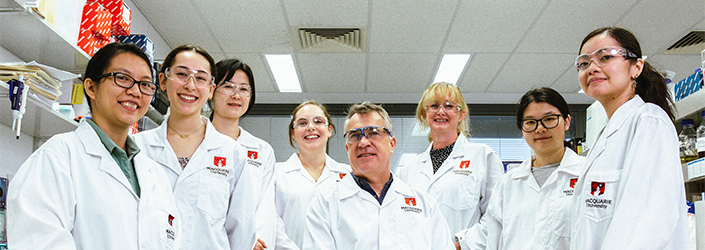
Genetics and genomics
Mapping MND patients’ genomes leads researchers to identify inherited genes that cause or increase the risk of developing MND.
If we can identify which genetic or genomic factors make the motor neuron die, we can work to design new diagnostic tests and therapies to:
- delay the progression of the disease
- maximise the length and quality of life for MND patients.
Led by Professor Ian Blair, the team analyses DNA gathered from patient samples kept in the Neurodegenerative Disease Biobank.
The genetic information Blair’s team identifies is channelled back into the Multidisciplinary MND Service and Clinic to inform the genetic counsellors who work with MND patients and their families.
Finding a hereditary genetic cause for MND can have an enormous impact on individuals and families.
Patients with familial MND can undergo genetic diagnostic testing that can now identify a known mutation in about two-thirds of these families, which means it can:
- lead to more rapid diagnosis of the disease
- allow patients to take part in clinical trials more quickly.
The team is also in the process of identifying and cataloguing gene variations that put people at risk of developing sporadic MND.
Group leader: Professor Ian Blair
Team leader:
Group members:
- Aron Charelian
- Amy Ding
- Dr Emily McCann
- Masoud Sheikhi Shoushtari

Genomics and bioinformatics
Among the Australian families participating in our research, there are more than 100 MND families without a known genetic defect. Associate Professor Dr Kelly Williams believes that work on ‘cryptic relatedness’ may lead to answers for these families.
We are hunting for the genetic connections that link MND patients to their extended families and more distant relatives around the world.
Our investigation takes a multi-faceted approach:
- Genomic analysis: Our first step is to examine DNA samples from MND patients. Using algorithms developed by team member Dr Lyndal Henden, we find shared regions of the human genome that have come from a common ancestor.
- Uncovering genetic defects: We then search within these ancestral regions of the human genome to pinpoint the specific genetic defect in the DNA sequence that causes MND.
- Exploring genetic modifiers: Bioinformaticians then look at the genetic modifiers of the disease that could influence when MND develops and how rapidly it progresses. These biological modifiers may be present in either DNA or RNA.
In 2022, we received funding from the National Health and Medical Research Council (NHMRC) to expand our MND genome dataset to include more than 10,000 international MND patients from New Zealand, United Kingdom, Europe and North America.
We are collaborating with the University of Auckland, King’s College London and Project MinE – a global MND genome sequencing consortium comprising 20 countries – to further this research.
Group leader: Associate Professor Kelly Williams
Team leader:
Group members:
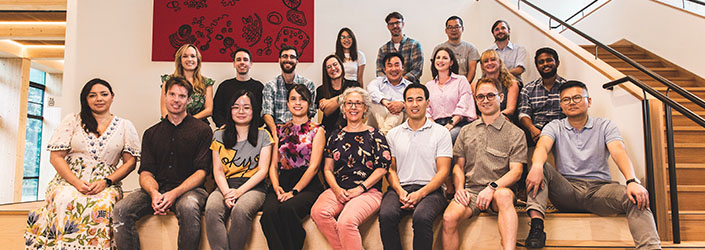
Neurochemistry and molecular therapeutics
Professor Roger Chung and the neurochemistry and molecular therapeutics team are at the forefront of developing a new gene therapy for MND.
Our work is supported by significant financial backing from the University, accelerating our research beyond academia and into commercial therapeutic development. This funding has enabled us to transition our therapies from the laboratory – where they were initially tested on animal models – to the clinical setting.
In 2008, Professor Ian Blair, together with national and international collaborators, made the seminal discovery of mutations in the TARDBP gene (which encodes TDP-43 protein) in some Australian MND patients (and patients worldwide) – revealing the TDP-43 protein as the key player in the disease.
In 2016, Blair’s genetics and genome team discovered mutations in the CCNF gene (which encodes Cyclin F protein) in MND patients and Chung’s team embarked on research to understand how that gene caused motor neuron degeneration.
Dr Stephanie Rayner subsequently made a pivotal discovery during her PhD research. She found that experimentally over-expressing a therapeutic variant of Cyclin F above normal levels could target TDP-43 and prevent MND-like neurodegeneration.
Rayner’s findings, published in 2022, led Chung’s team to:
- develop the potential gene therapy
- apply for multiple patents
- seek to commercialise the research.
With support from Celosia Therapeutics, Chung’s team is now advancing the gene therapy through pre-clinical development, paving the way for human trials and commercialisation.
Group leaders:
Team leader:
Group members:
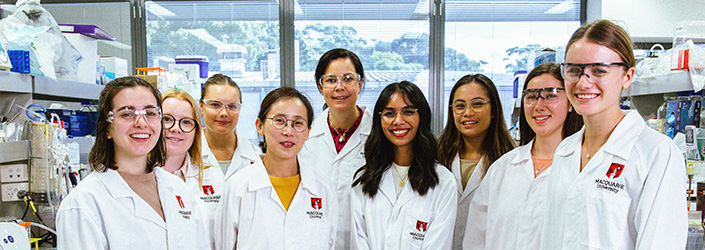
Neurodegeneration treatment
Researchers within the neurodegeneration treatment team are testing potential treatments on zebrafish and rodent models. These studies help us:
- understand the degeneration of the nervous system that occurs in people with MND
- discover the most promising treatments.
In our pursuit of effective MND therapies, the team is now conducting short-term targeted testing on rodent models, to ensure the treatment can reach their brains, before expanding into longer studies.
This approach involves implanting fibre optic microscopes into the rodent models to watch whether the treatment is affecting levels of a fluorescent marker. The marker allows us to see, in real time, whether a treatment is hitting its target. We can then identify if we need to increase the dose or change the administration route of the treatment.
The researchers then undertake a longer ‘efficacy study’ of the therapy, to observe whether it prevents the animals from developing neurodegeneration or movement deficits. This process ensures that the treatments we examine in the lab have the best chance of making it into the clinic.
Group leader: Associate Professor Angela Laird
Group members:
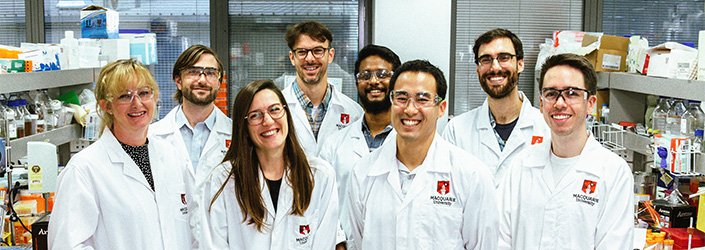
Neuroimaging and degeneration
Associate Professor Marco Morsch’s Neuroimaging team works to better understand fundamental mechanisms how disease proteins cause pathology. Understanding these principles is critical to develop novel and affective therapies.
The diverse team uses a range of models (cells, zebrafish and mice) and technologies (advanced microscopy) to answer a range of questions:
- how MND disease proteins clump together within nerve cells
- how these cells circulate throughout the nervous system
- how this process can be targeted to help people living with MND.
With support from international funding agencies, Morsch’s team is at the forefront of molecular and cellular scientific discoveries.
Morsch believes that zebrafish provide researchers a fast track to test compounds and assess how they affect critical mechanisms.
Because zebrafish embryos and juveniles are transparent, we can:
- use fluorescent markers in the fish to label the proteins and motor neurons
- observe under the microscope how MND develops and spreads within these nerve cells.
This allows the researchers watch in real time, how motor neurons respond to the disease and how the cells in the brain and spinal cord battle these disease aggregates.
This work delves into the ‘molecular grammar’ of the cell, seeking to understand the fundamental drivers that regulate TDP-43, the hallmark protein in MND.
Over the last year, Morsch has received a grant from the National Institute of Health, one of the largest research funders in the US, enabling us to expand our team and hire post doctoral researchers.
Group leader: Associate Professor Marco Morsch
Team leader:
Group members:
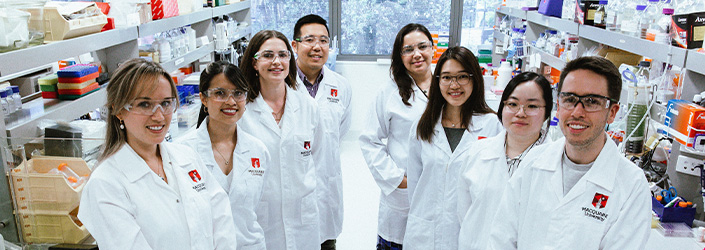
Neuroproteomics
Researchers from the neuroproteomics team are moving towards discovering how to manipulate proteins to halt motor neuron defects.
By identifying key proteins involved in the initial stages of protein aggregation, or clumping, we aim to determine:
- how defects make the protein toxic
- how it affects the motor neurons and their loss that ultimately cause MND.
Led by Dr Albert Lee, the neuroproteomics research team is working to holistically understand the dynamic changes that occur during stress and survival of a cell with MND gene mutations. We collaborate with other teams to further develop hypotheses and ultimately reduce the effects of motor neuron disease.
In individuals without MND, TDP-43 proteins stay within the cell’s nucleus. However, in more than 97 per cent of patients with MND, the TDP-43 moves outside the cell’s nucleus to form clusters. Lee’s team found this abnormal behaviour alters normal protein pathways and prevents repair within cells.
The team is making significant headway in identifying key proteins that are central to the initial stages of MND-specific protein clumping. Our research explores how factors such as gene mutations and environmental stressors influence these proteins, making them toxic and contributing to motor neuron deterioration.
This study of proteomics in the context of MND is still in its early stages, putting the centre at the forefront of this research.
Group leader: Dr Albert Lee
Group members:
- Flora Cheng
- Dr Jennilee Davidson
- Chiara Yap Macaslam
- Yuma Okamoto
- Dr Stella Pollido
- Dr Stephanie Rayner
- Selina Zhang